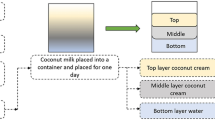Abstract
The seeds ofLupinus mutabilis show on average a protein content of 42.6% and a fat content of 18.7%. Unfortunately they contain up to 4.5% of bitter alkaloids which must be removed before consumption. Edible oil and protein concentrate were produced from the seeds at an industrial level. The oil is of good quality and is recommended for human nutrition. The main fatty acid is oleic while the main tocopherol is γ-tocopherol. During the refining process, which includes a washing process with aqueous acids for debittering, the alkaloid content of the oil is reduced to 5 ppm. During the extraction of the oil the alkaloids are concentrated in the oil cake, from which they can be removed by washing with an ethanol-water mixture. A protein concentrate containing 72.3% protein and 0.06% residual alkaloids is obtained. The analysis of alkaloid pattern by gas-chromatography showed that the alkaloid composition of the crude oil differs totally from that of the seed. The relative percentage of the alkaloid esters and that of the Tetrahydrorhombifoline are very much higher in the oil than in the seed. During the debittering process of the oil cake the relative percentage of the hydroxylupanines increases.
Similar content being viewed by others
References
Analytical Methods Committee (1959) The determination of tocopherols in oils, foods and feeding stuffs. Analyst 84:356–376
AOAC (Association of Official Analytical Chemists) (1975) Official methods of analysis, Washington
Baer Dv, Feldheim W (1982) Alkaloids in Lupinus mutabilis. In: Gross R, Bunting ES (ed.): Agricultural and nutritional aspects of lupines, GTZ, Eschborn, FRG
Baer Dv, Reimerdes EH, Feldheim W (1979) Methoden zur bestimmung von Chinolizidinalkaloiden in Lupinus mutabilis I Schnellmethoden. Z. Lebensm. Unters. Forsch 169:27–31
Blaicher MF, Nolte R, Mukkerjee KD (1981) Lupin protein concentrates by extraction with aqueous alcohols. J Am Oil Chem Soc 58:761–765
Bocanegra M, Elmadfa I, Gross R, Hatzold T (1982) Lupinus mutabilis seeds for edible oil production. In: Gross R, Bunting ES (ed.): Agricultural and nutritional aspects of lupines, GTZ, Eschborn, FRG
Brubacher G, Weiser H (1967): Biologische Wirksamkeit von Tocopherolen und von Antioxydantien in: Lang, K. (ed.): Tocopherole (Wissenschaftliche Veröffentlichungen der DGE Vol. 16) Steinkopf, Darmstadt, FRG
Couch JF (1926) Relative toxicity of lupine alkaloids. J Agric Res 32:51–67
DGF (deutsche Gesselschaft für Fettwissenschaft) (1979) Deutsche Einheitsmethoden zur Untersuchung von Fetten, Fettprodukten und verwandten Stoffen. Wissenschaftliche Verlagsgesellschaft, Stuttgart, FRG
Gladstones JS (1970) Lupines as crop plants. Field crop abstracts 23:123–148
Gross R, Baer Ev (1975) Die Lupine, ein Beitrag zur Nahrungsversorgung in den Anden 1. Allgemeine Gesichtspunkte. Z. Ernährungswiss 14:224–228
Hackbarth J, Troll HJ (1959) Lupinen als Körnerleguminosen und Futterpflanzen. In: Kappert-Rudorf (ed.): Handbuch der Pflanzenzüchtung. Paul Parey Berlin-Hamburg
Hansen RP, Czochanska Z (1974) Composition of the lipids of lupine seed (Lupinus angu stifolius L. var. ‘Uniwhite’) J Sci Fd Agric 25:409–415
Hatzold T, Elmadfa I, Gross R, Wink M, Hartmann T, Witte L: Quinolizidine alkaloids in seeds of lupinus mutabilis (in preparation)
Hatzold T, Gonzales J, Bocanegra M, Gross R, Elmadfa I (1982) Possibilities of lupine debittering through extraction with different solvents. In: Gross R, Bunting ES (eds.): Agricultural and nutritional aspects of lupines, GTZ, Escborn, FRG
Hudson BJF, Fleetwood JG, Zand-Moghaddan A (1976): Lupin, an arable food crop for temperate climates. Plant Foods for Man 2:81–90
Müller-Mulot W, Rohrer G, Medweth R (1976) Schnellmethode zur quantitativen Bestimmung individueller Tokopherole in Ölen and Fetten. Fette Seifen Anstrichmittel 78:257–262
Schoeneberger H, Sam O, Cremer HD, Elmadfa I, Gross R (1982) Protein quality of Lupinus mutabilis and its influence through preparation and supplementation. In: Gross R, Bunting ES: Agricultural and Nutritional aspects of lupines. GTZ, Eschborn, FRG
Torres F (1976) Lupinus mutabilis Sweet- a potent food source from the Andean region. Am J Clin Nutr 29:933
Walter A (1981) Gibt es eine Hypervitaminose E? Biochemische und hämatolo gische Untersuchungen an Meerschweinchen und Rattan. Dissertation Giessen
Author information
Authors and Affiliations
Rights and permissions
About this article
Cite this article
Hatzold, T., Elmadfa, I. & Gross, R. Edible oil and protein concentrate fromLupinus mutabilis . Plant Food Hum Nutr 32, 125–132 (1983). https://doi.org/10.1007/BF01091333
Received:
Revised:
Issue Date:
DOI: https://doi.org/10.1007/BF01091333




